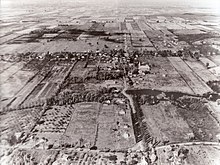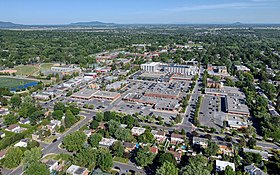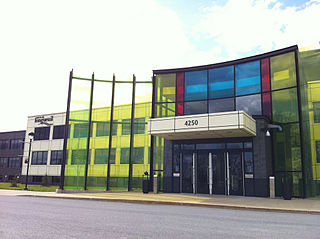
Longueuil is a city in the province of Quebec, Canada. It is the seat of the Montérégie administrative region and the central city of the urban agglomeration of Longueuil. It sits on the south shore of the Saint Lawrence River directly across from Montreal. The population as of the Canada 2016 Census totalled 239,700, making it Montreal's second largest suburb, the fifth most populous city in Quebec and twentieth largest in Canada.

Boucherville is a city in the Montérégie region in Quebec, Canada. It is a suburb of Montreal on the South shore of the Saint Lawrence River.
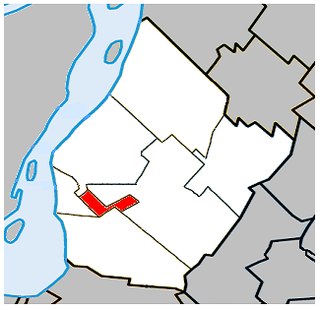
Greenfield Park is a former city in southwestern Quebec, Canada. It is currently a borough of the city of Longueuil. It covers an area of 4.78 square kilometres (1.85 sq mi), with a population of 16,733 at the 2016 census of Canada. Greenfield Park is the only borough of Longueuil that has an officially bilingual status. It is primarily a post-WWI suburban area. Like the other two boroughs, most of the buildings in Greenfield Park are single-family homes. Nearly all of the land in Greenfield Park is built on, making it Longueuil's most densely populated borough.

Sainte-Julie, is an off-island suburb of Montreal, in southwestern Quebec, Canada, east of Montreal in Marguerite-D'Youville Regional County Municipality. The population as of the Canada 2021 Census was 30,045. In 2009 Sainte-Julie was called one of the best towns in which to live in Quebec, and the city is often known as "The Happiest City in Quebec".

Beloeil is a city in Quebec, Canada. It is a suburb of Montreal, on the South Shore and is on the Richelieu River, 32 kilometres (20 mi) east of Montreal. According to the official Commission de toponymie du Québec, the name is written Belœil with an oe ligature; however, other sources avoid the ligature, including the Ministry of Municipal Affairs and the town's own official website.
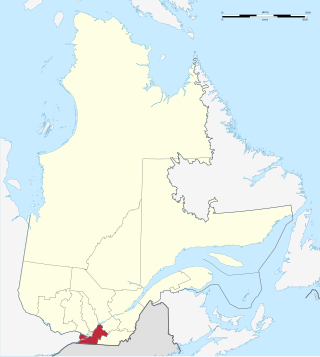
Montérégie is an administrative region in the southwest part of Quebec. It includes the cities of Boucherville, Brossard, Châteauguay, Longueuil, Saint-Hyacinthe, Saint-Jean-sur-Richelieu, Salaberry-de-Valleyfield and Vaudreuil-Dorion.
The 2000–2006 municipal reorganization in Quebec resulted in large-scale amalgamation of smaller municipalities in Quebec into larger cities. It was undertaken by one administration, and modified and partially undone by its successor.
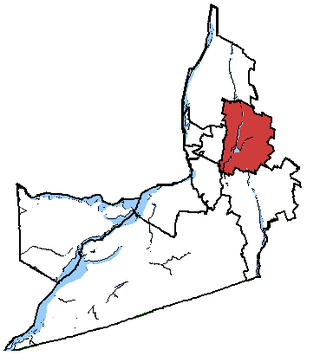
Chambly—Borduas was a federal electoral district in the province of Quebec, Canada, that was represented in the House of Commons of Canada from 1867 to 1935, and from 1968 to 2015. Created by the British North America Act of 1867, its name was changed in 1893 to "Chambly—Verchères". In 1933, it was amalgamated into the Chambly—Rouville and Richelieu—Verchères electoral districts. The district was re-created in 1966 from Chambly—Rouville, Châteauguay—Huntingdon—Laprairie, and Richelieu—Verchères. Its name was changed in 2003 to "Chambly—Borduas". In 2015, most of the district became part of Beloeil—Chambly, while small parts of it joined Montarville and Pierre-Boucher—Les Patriotes—Verchères.

Verchères—Les Patriotes was a federal electoral district in Quebec, Canada, that was represented in the House of Commons of Canada from 1979 until the 2012 electoral redistribution.

Réseau de transport de Longueuil (RTL) is a public transit system in the city of Longueuil, Quebec, Canada, and nearby communities on the South Shore of Montreal. The RTL had an annual ridership of 34,447,686 in 2013.
Claude Gladu is the former mayor of the city of Longueuil, Quebec. He served as mayor from 1994 to 2001 and from 2005 to 2009.

The South Shore is the general term for the suburbs of Montreal, Quebec located on the southern shore of the Saint Lawrence River opposite the Island of Montreal. The South Shore is located within the Quebec administrative region of Montérégie.
François-Pierre Bruneau was a lawyer, seigneur, businessman and political figure in Canada East.
An agglomeration, or urban agglomeration, is an administrative division of Quebec at the local level that may group together a number of municipalities which were abolished as independent entities on 1 January 2002 but reconstituted on 1 January 2006.

The urban agglomeration of Longueuil was created on January 1, 2006 as a result of the de-amalgamation process brought upon by the Charest government. It encompasses all the boroughs that were merged into the previous city of Longueuil and still retains the same area as that mega-city.
Tancrède Boucher de Grosbois was a physician and political figure in Quebec. He represented Shefford in the Legislative Assembly of Quebec from 1888 to 1892 and from 1897 to 1903 as a Liberal.
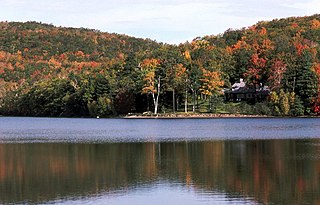
Mont-Saint-Bruno Provincial Park is a small national park of Quebec located near the municipality of Saint-Bruno-de-Montarville, 15 kilometres (9.3 mi) to the east of Montréal on the south shore of the Saint Lawrence River. The park, with an area of 8.84 square kilometres (3.41 sq mi), notably includes Mont Saint-Bruno, one of the Monteregian Hills which peaks at 218 metres (715 ft). The mountain is shared with the Ski Mont Saint-Bruno ski resort, a quarry and a small Canadian Forces training camp. Despite its relatively small size, the mountain is known for its rich fauna and flora. Situated at the heart of the old signory of Montarville, its many lakes have permitted the construction and exploitation of many water mills, contributing to the region's economical success. A building from one of those mills, the "Vieux Moulin", still stands to this day and is used as a rest area for skiers and hikers in different seasons.
Champlain was a former regional county municipality and census division in the Canadian province of Quebec. It ceased to exist when it amalgamated into the expanded city of Longueuil on January 1, 2002.





